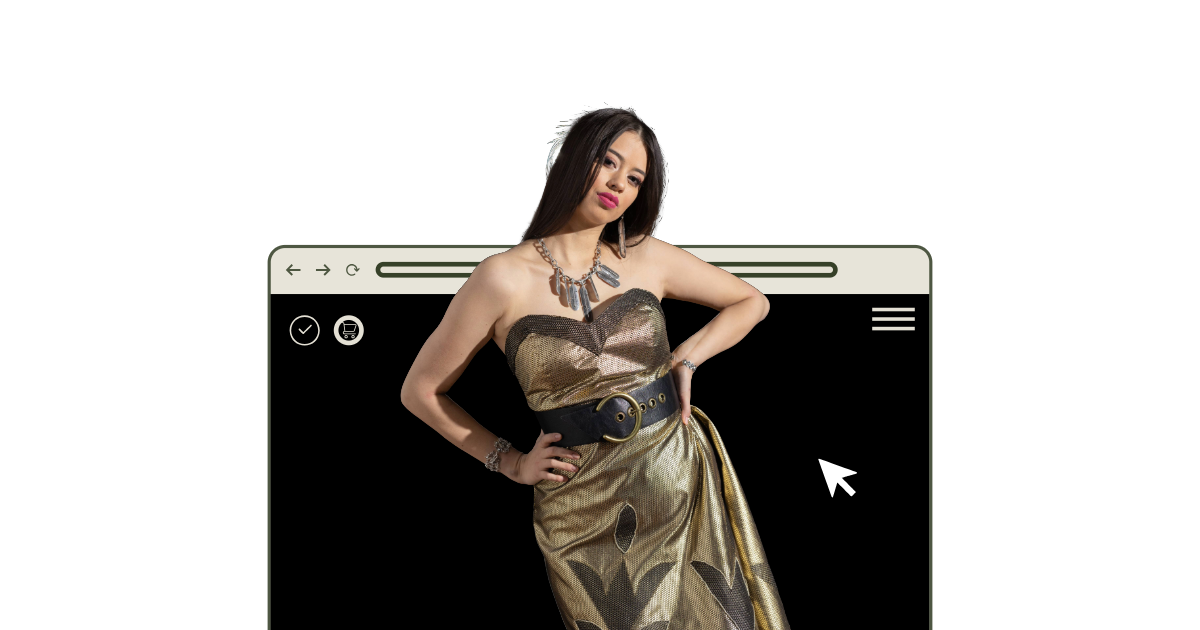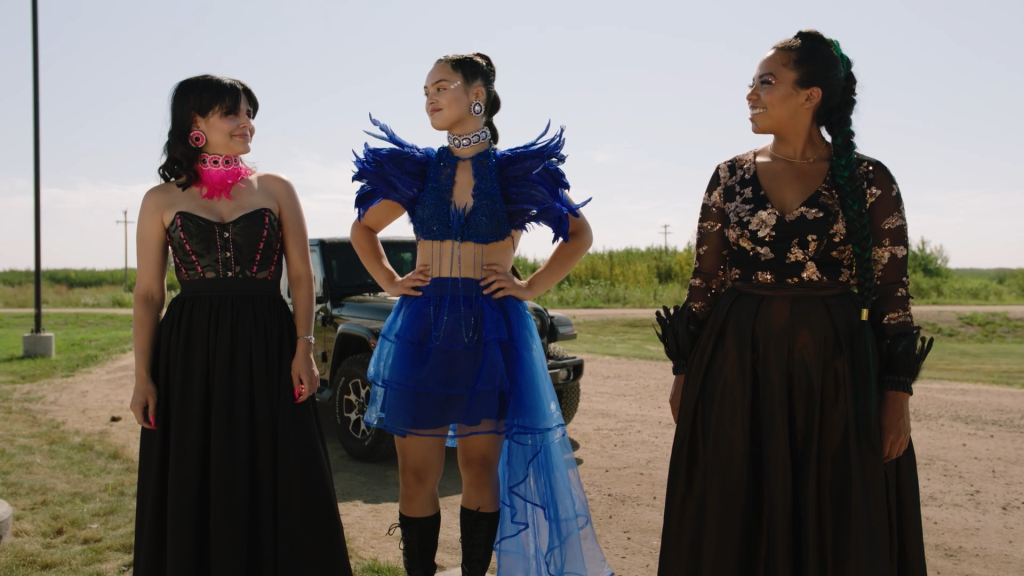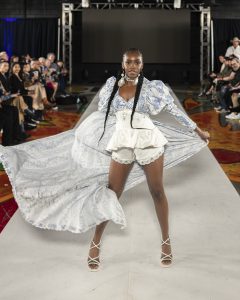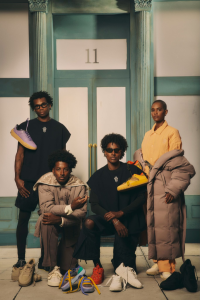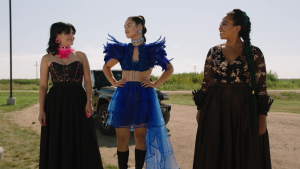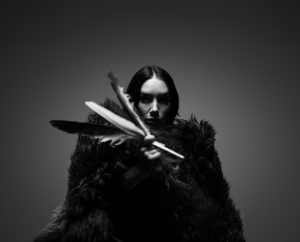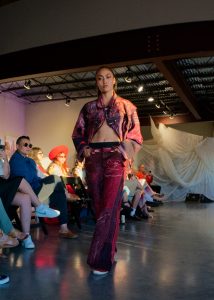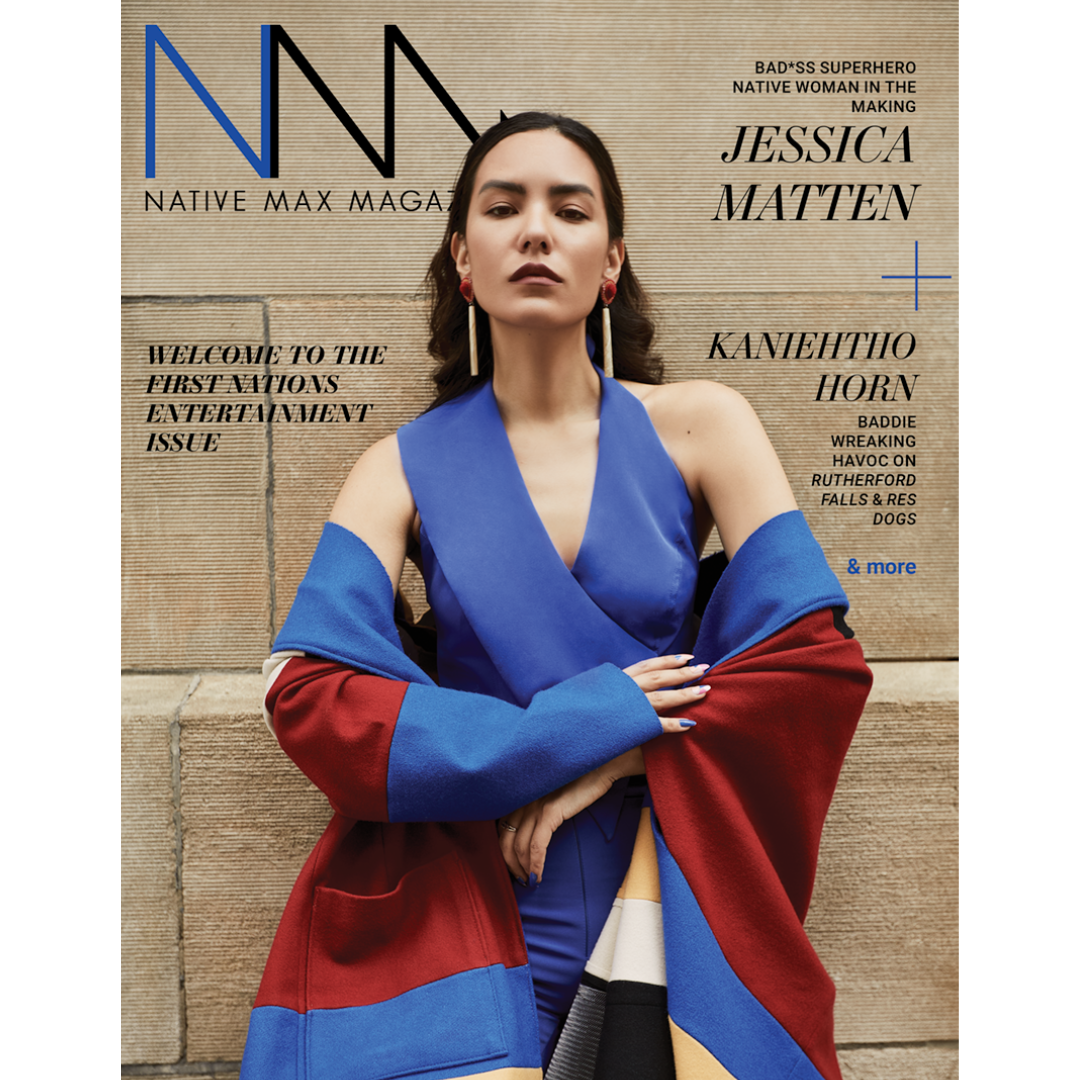Select a subscription plans
You need a subscription to access this content.
Roseanne Supernault (Whitefish Lake Atikameg First Nation, Treaty 8 territory, Canada), long admired for her powerful screen presence, now steps behind the camera with her directorial debut, Dusk & Dawn. Premiering at the 2025 Calgary International Film Festival, the satirical dark comedy follows two exes as they navigate love, choices, and identity in the prairie town of Skyville. Produced by an all-female team and filmed on Treaty 6 territory, the project brings together BIPOC, Indigenous, and first-time filmmakers to tell a story that feels both timeless and unapologetically fresh. Adding to its bold vision, Indigenous couture designer Helen Oro (Plains Cree from Pelican Lake First Nation) brings her artistry to the screen, merging fashion with storytelling in unforgettable ways.
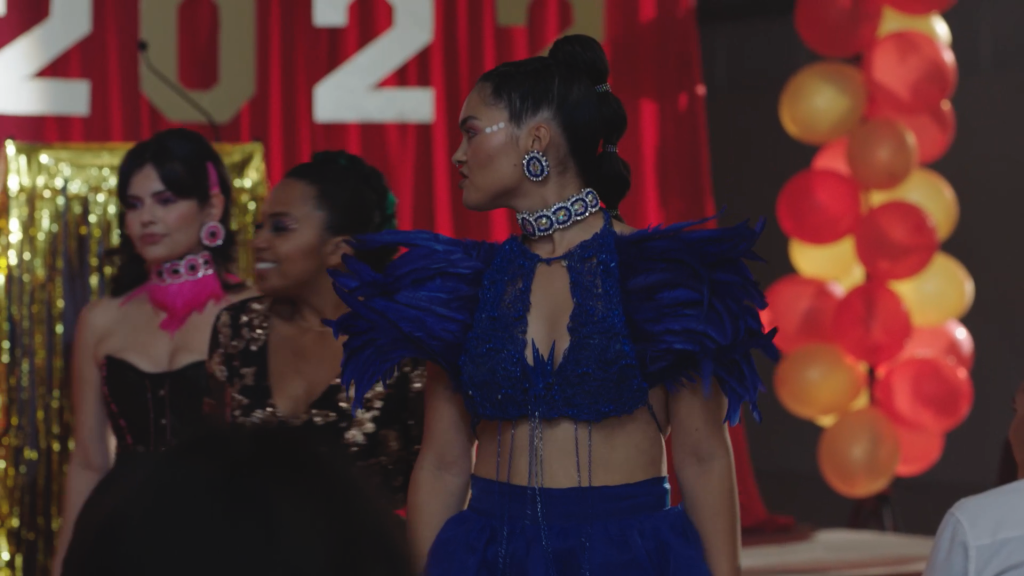
Roseanne, Dusk & Dawn is your directorial debut. What inspired you to tell this story as a satirical dark comedy, and why now?
At the end of 2020, I found myself daydreaming a lot about my old friends from back home, and all the shenanigans we used to get up to. We took care of one another. I was actually quite depressed at the time, and I started watching Dusk & Dawn in my head like a movie. Writing is my first love, so I put pen to paper in March of 2021. I cried a lot. The script just flowed out of me, and I wrote it in about four days. I know that sounds crazy, it was, but sometimes these things happen. They mostly don’t, for example: I have a script I’ve been working on for over twelve years now; I’m on the 100th edit or so, I don’t know when it will be “done,” but Dusk & Dawn was like a baby just waiting to be born. I mean, I went through script doctoring and intense revisions later on, but the first draft, yeah, it was quick. My producing partner at the time encouraged me and played a big role in our submitting it for funding. We got greenlit right away. Freaking miracle, I tell ya.
The film was shot in Treaty 6 territory, specifically in Frog Lake First Nation and the Fishing Lake Métis Settlement. How did grounding the movie in these homelands shape the storytelling and atmosphere of Dusk & Dawn?
First of all, a huge shout-out to St Paul, Frog Lake, and Fishing Lake! Couldn’t have done this without youse! The land is of great importance in our culture. I really look up to Darlene Naponse. I’ve been fortunate enough to work with her as an actress, and in her films, the land is very much a character itself. While I am not the master she portrays the land as, I feel that energy reaches through the screen to the audience, so filming authentically in a territory that not only looked like my own but felt like my own was important. I’m both Métis and Treaty, and I grew up on a Métis Settlement and still spend a lot of time at home. Filming in both the Reserve and on a Métis Settlement felt like a personal signature because, as I’ve adamantly shared with my Indigenous friends and contemporaries for years, if you put a camera in one or the other, you really can’t tell the difference.
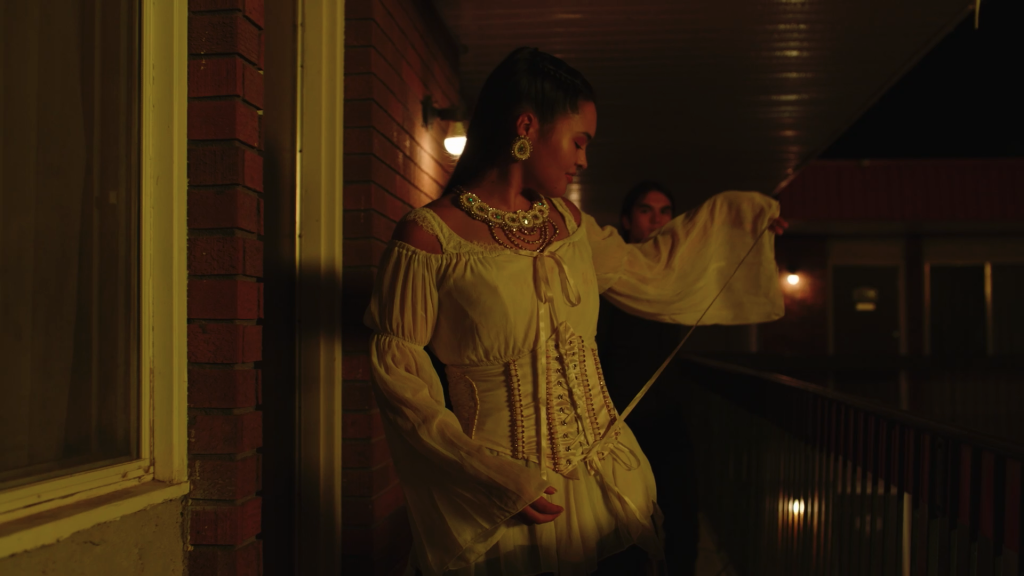
Dusk & Dawn also touches on sensitive issues like racism and discrimination that are still present factors in the prairies of Canada today. It’s still an issue throughout the country, but it feels acute in the prairies. I am from the school of thinking that I hope we can all get along… But some things must be addressed. I hope I put the right amount of those themes in the script. I hope that what is felt by the audience resonates as truthful, and my only intention is to hold up a mirror so we can all reflect on how far we’ve come, as well as how much farther we have to go. Also, just because we deal with the topic of discrimination in the film, I certainly have no intention to play the victim, because our heroine quite literally handles it with a swift right hook.
This production was led by an all-female producer team and a crew made up mainly of BIPOC and first-time filmmakers. What did building this kind of set community mean to you, and what impact do you hope it has on the industry?
My company, Flying Up Moon Inc., has a hiring mandate for Equity, Diversity, and Inclusion. We worked with a phenomenal NPO to help us with the hiring process. Flying Up Moon is named after the full moon in August, in Cree/Nehiyawewin it’s “Opahowii-Pisim.” It’s the time of the year when the little eagles make their first attempts to fly from the nest. They’ve grown strong enough to try, and it is a major test of whether they’ll make it in nature. My company also decided to move forward with an endeavour in hiring BIPOC folks, while having an all-female producing team. It sounds great on paper, but it does take a ton of work, and unfortunately, there was a lot of fallout from it. If I had to go back in time, to be quite frank, I would have done things differently. I would have focused just on first-time filmmakers, which in and of itself is a lot of work for everyone.
While I was transparent about this first-timer endeavour in the hiring process, none of us could have anticipated how it would play out on set. We found our groove a week or so into shooting. Many seasoned or veteran filmmakers on set took on a more mentorship role. This was all happening while we were dealing with various schedules, commitments to other projects, and inexperience, including my own. I’m grateful for the crew who mentored others and also came to help on D&D, even for just one week or three days, because everything they did counted. Crewing up is never easy, but I have to give a shoutout to Jessie Anthony, who is an absolute icon! To know Jessie is to love her; thank God she was part of Dusk & Dawn. For our crew, we had people who had never set foot on a film set before, as well as more experienced filmmakers who were in their respective positions for the first time, or individuals with experience in their department who were promoted to head that department on this film. It was a bit nuts, but it was also electric.
In terms of impact, I hope to share the lessons I’ve learned, pass the torch, and inspire others. The main takeaway from this experience is that in the same way I have an entire team for camera, a team for lighting, a team for costume, etc, I also need a support team for first timers, like a literal mental health counselor, and also a team for EDI, and I didn’t have those. Those things are novel for anyone who has been in this industry for decades, but I hope that becomes the norm in the future. It was a mistake on my part not to have a specific team for that. Now I have the experience to know better. Another aspect that played a role in the way we created our team was crewing up in Alberta. It can be challenging when filming an indie outside a city that has lost many crew members to bigger Canadian metros. You’re also a first-time director, and people have only heard of you as an actor, so you’re going up against The Last of Us and a couple of other huge productions. I mean, you get a phone call from The Last of Us, and you have this first-time Native Actress-turned-Director filming Dusk & Dawn on the other hand, offering to pay you maybe less than half on a road show. Who are you going to pick? I have learned many valuable lessons on this project, as well as in my EDI endeavors, and I now know that the next time I approach building inclusion into my company, I’ll have a comprehensive list prepared of what that entails. That all being said, you can’t watch this film and argue that those groups don’t deserve to be in these spaces, because they/we do. My jaw dropped when I started seeing dailies, and especially once I started editing. It was the best feeling in the world.
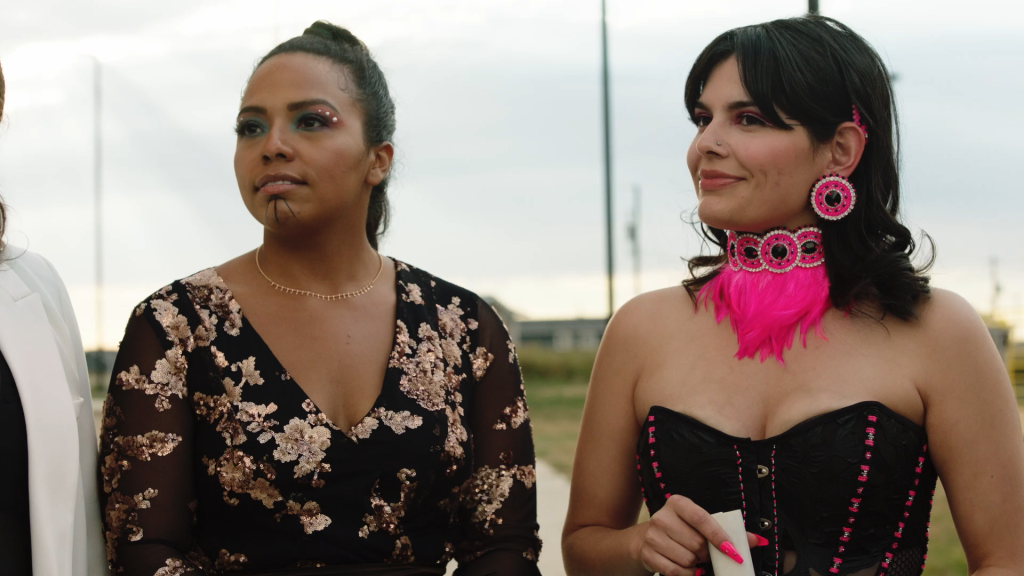
The central love triangle explores themes of home, leaving, and identity. How much of that tension reflects your own experiences or those of your community?
In terms of identity, my sisters and I had a huge love for style and fashion throughout our lives, we used to wear pow-wow makeup just on a day to day basis. In my eyes, we were kind of like these punk rockstar youth, who loved hip hop, and strived to find anything non-mainstream or non-colonial, who were coping with discrimination daily; so our style and sense of fashion was our way of saying, “f*ck you, we’re Native and we make it look good!” I wanted that feeling of rebellion and style to exist in Dusk & Dawn, so I knew I wanted this to be a fashion-centered film. That’s why I loved having the lead wear combat boots with a graduation dress designed by Helen Oro Designs. Identity is something we have the privilege of expressing physically through style and fashion. Something I admire about Helen is that she can take random items and make them look like a brand-name product. Once, I saw her buy a pair of slides from a dollar store. Or something like that. Then, with a variety of crafting items, she created new slides, and you could have set the finished product next to Dior or Louis Vuitton, and they’d look right at home. She is truly an artist among artists. Having Helen on this project was a thrilling experience; collaborating with her was a dream come true. One thing I’m most proud of is discussing costume designs with her and concepts for the pieces in the film. I had a vision for each character, and Helen was right there with me, never missing a beat, and making my wildest fashion dreams a reality. I was also heavily inspired by the 90s era, and I think that the fashion pieces Helen designed and curated reflect that as well.
A major part of identifying as Métis is also this strange sense of finding your own belonging between two or more worlds. You can feel alienated by both white people and Native people, and it’s strange. Many Métis people, in Alberta at least, were in fact disenfranchised non-Status Indians who wound up living in the ditch–on their own land, all because they refused to sign treaties. They weren’t allowed in town or on the Reserve; thus, the creation of Métis Settlements, where many of “The Road Allowance People” eventually migrated. They simply refused to concede to colonialism, even if it meant living in the damn ditch. I come from these people, as well as Red River Métis and Treaty people. A significant theme I explored in the creation of Dusk & Dawn was the discomfort of feeling unwanted and finding your footing despite it. This story is also about what it feels like to be in love for the first time, and all the emotions and complexities that come with it. First love is many things; usually, you’re young, so retrospectively it can be awkward, intense, and something you never forget. The image I had throughout this project was like when you watch a foal being born, and it gets on its legs right away. They’re just falling all over the place. It’s adorable. It’s also reminiscent of a fawn, too, just in a meadow, falling around all over. I hope that awkwardness comes across to people on screen. And in some meta way, I also felt like that fawn while making this film.
What do you hope audiences—especially Indigenous youth—take away from seeing Dusk & Dawn on the big screen at its world premiere?
I hope that people feel a sense of being seen. I’ve always had the greatest of friends, truly, but even then, sometimes I feel like a lone wolf. Sometimes, when I watch a film, I admire what I’m seeing in the cinema, but I don’t always see myself reflected on screen. Having had such a specific experience growing up Métis-Cree in Alberta, on the Canadian prairies, I knew I wasn’t the only one. I made this film in the hope that those who feel different or awkward can see themselves reflected in it. Sort of a wink from the storytelling world, like, “hey, I see you too.” For Indigenous youth especially, I hope you know you’re not alone. And I think the decision our lead character has to make is something a lot of Indigenous youth can relate to. And the bottom line is this: Dawn has to decide whether to leave the nest, to make her dreams come true, and fly the way she wants to.
As Dusk & Dawn prepares to make its world premiere, Supernault’s vision marks an exciting new chapter for Indigenous storytelling in film. With an all-female producing team, a cast and crew filled with BIPOC and first-time creators, and the seamless integration of Indigenous couture, the project is both a cinematic triumph and a cultural statement. For Roseanne, this is only the beginning of building a filmmaking journey rooted in representation, authenticity, and bold new voices.
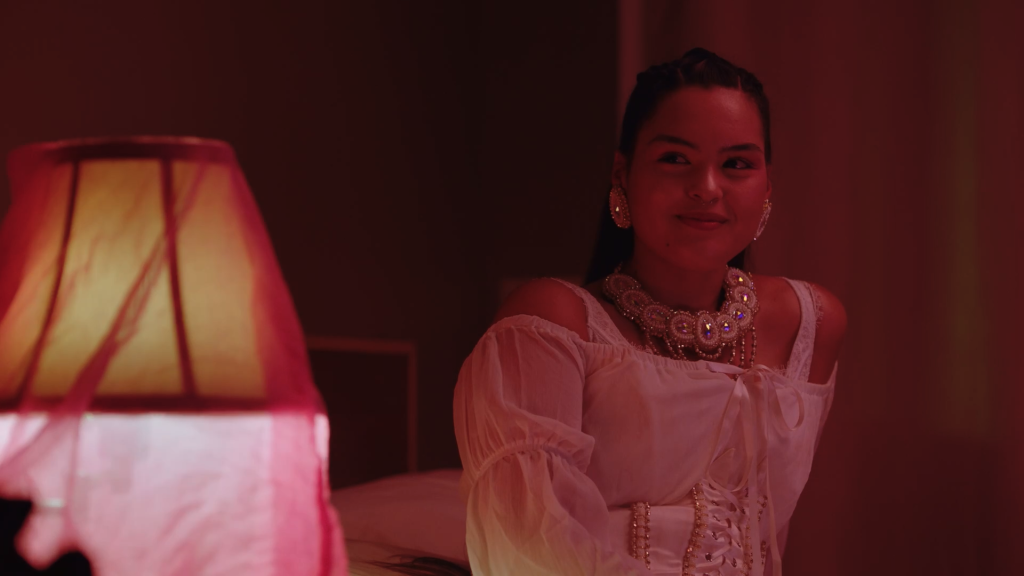
Now, Helen, your couture designs are woven into the fabric of Dusk & Dawn. How did you approach designing for a satirical dark comedy, and what did you want the costumes to communicate about the characters?
Designing outfits for a satirical dark comedy like Dusk & Dawn required a thoughtful approach to convey the characters’ personalities and traits while maintaining the show’s tone. We wanted the looks to be wow factors for the characters. Ultimately, the goal for the designs for certain scenes in this satirical dark comedy was to create a visually engaging and thought-provoking narrative that complemented the show’s tone and themes. By considering the characters, costume design elements, satirical elements, and character traits, I worked with Roseanne closely to create designs that enhanced the story of each character and that I’m sure will leave a lasting impression on the audience.
Can you share a piece or look from the film that you feel especially captured the spirit of Indigenous fashion on screen?
For me, I can’t just pick one, but I guess if I had to, I’d say the beaded statement sets were my favorite. For me, beading has always been a healing tool, and I’ve always envisioned my work appearing on the big screen while I bead. For us natives, beading has been more than just how it looks; it feels and makes others feel. It’s a form of prayer, healing, and storytelling. It’s beautiful that I can share this through this special film.
What was it like collaborating with Roseanne and the team to merge high-fashion Indigenous couture with cinematic storytelling?
This is my first experience as an in-house designer for a film, and I was thrilled to be invited to participate in a project of this caliber. Historically, I have created avant-garde looks that have sparked curiosity, with people often inquiring, “Who’s going to wear that?” Therefore, when Roseanne reached out about this opportunity, I was confident in my ability to take it on and create designs that would be perfectly suited for this film. If anything, Roseanne’s enthusiasm was contagious, and she further energized me about the project. I had a fantastic experience collaborating with Roseanne, who possessed a clear vision from the outset, which greatly facilitated my design process. It seemed that as soon as she would brief me on a character, I instinctively knew what I could create or help style.
How do you see Indigenous fashion evolving within film and television, and why is it essential to see couture like yours in stories such as Dusk & Dawn?
Indigenous fashion in film and television is evolving rapidly, driven by a growing demand for authentic representation and storytelling. Designers are incorporating traditional elements into modern designs, showcasing cultural symbolism and sustainable practices. This shift is significant, as it challenges historical misrepresentations and stereotypes perpetuated by the dominant non-Indigenous society.
In stories like Dusk & Dawn, couture designs can enhance authenticity by incorporating Indigenous designs and symbolism, and costumes can add depth and authenticity to the narrative. Amplifying Indigenous voices through showcasing Indigenous fashion in film and television, providing a platform for storytelling and cultural expression. Lastly, challenge dominant narratives by centering Indigenous perspectives. These stories can challenge dominant narratives and offer fresh, nuanced portrayals of Indigenous experiences.
With its world premiere in Calgary, Dusk & Dawn is more than just a film—it’s a statement. From Roseanne Supernault’s bold leap into directing to Helen Oro’s powerful couture designs, the project showcases what happens when Indigenous voices lead both in front of and behind the camera. At once funny, tender, and stylish, Dusk & Dawn embodies the next wave of Indigenous cinema: one where stories are authentic, fashion carries meaning, and communities see themselves reflected in every frame.

